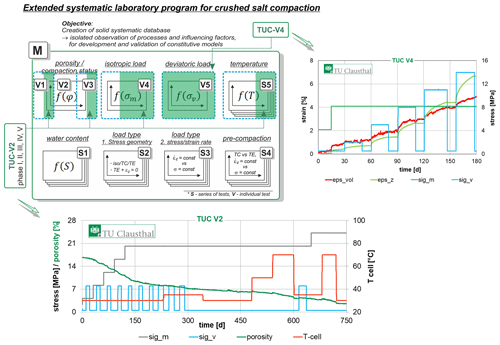Systematic laboratory investigations concerning the reduction of uncertainties related to the modeling of the material behavior of crushed salt
The planned use of crushed salt as the backfill and sealing material in the context of the final disposal of radioactive waste in rock salt is justified and favored by the realization that the material properties of loosely deposited crushed salt will be transformed into the material properties of in situ rock salt in the long term by the convergence of the viscous rock salt mass. In other words, the convergence-induced compaction of crushed salt ultimately results in a nearly pore-free material, with a tightness and creep capacity corresponding to that of the ambient rock salt mass.
The computational prognosis of the load-bearing and sealing behavior required for the long-term safety assessment of underground repositories requires a sufficiently proven physical modeling of the, in general, three-dimensional load bearing and permeability behavior of crushed salt. This requirement can only be met if the influencing variables on the load bearing and permeability behavior are sufficiently quantified and represented by mathematical–physical functions on the basis of suitable laboratory and field investigations. In order to eliminate or reduce the currently (still) existing scientific deficits and uncertainties concerning the general three-dimensional load bearing and permeability behavior of crushed salt, a systematized laboratory program was developed within the framework of the joint project KOMPASS (compaction of crushed salt for the safe containment), with the aim of ensuring an isolated recording of individual processes and influencing factors on the compaction behavior.
Based on this, triaxial long-term compaction tests, TUC-V2 and TUC-V4, with a test duration of 750 and 180 d, respectively, were carried out within the framework of the joint project KOMPASS and of the follow-up project KOMPASS II. Both tests, but especially TUC-V2 with its 2-year duration, represent a sequence of several loading phases for separate analysis of the effects of individual influencing factors on the compaction behavior of crushed salt. By integrating several loading phases in one long-term test each, it was possible, on the one hand, to eliminate the scattering of the material behavior that would have been expected if several individual tests had been carried out as an alternative and, on the other hand, to provide metrological evidence of the range of validity of the compaction behavior as a function of individual influencing factors for a comparatively wide range of different porosities in each case. The computational reanalysis of the long-term tests opens up the possibility of validating and strengthening the currently available constitutive model approaches with regard to their ability to influence several parameters on the compaction behavior, while eliminating the scatter band of the material behavior. The improvement of the existing constitutive model approaches up to the sufficient reproduction of the measurement results equals an increase in the validation status or the credibility of the constitutive models or, vice versa, a reduction in the uncertainties remaining due to (not yet) validated model assumptions.
Within the framework of the KOMPASS II joint project, a benchmark was carried out against the background outlined above for the comparative analysis of the constitutive models currently available to the project partners for depicting the compaction behavior of crushed salt with regard to their ability to computationally represent the measurement results generated within the TUC-V2 experiment. Specifically, the focus is on constitutive model functions that control the viscous compaction and shear deformation behavior and, within these functions, the influencing factors of mean stress, deviatoric stress, and temperature, which were recorded by laboratory tests for medium ranges of porosities from ≈ 16 % to very low porosities of ≈ 2.5 %.
Within the framework of the continuation of the investigations planned under the acronym MEASURES (Multi-scale Experimental and numerical Analysis of crushed Salt material Used as engineered backfill for a nuclear waste REpository in rock Salt), it is intended to continue the benchmark study with a more detailed investigation of the influence of the deviatoric stress, which includes considering the data from TUC-V4. It is also intended to supplement the laboratory data base with further experiments by (a) investigations on the compaction behavior in the range of high-to-medium porosities and (b) investigations on the influence of the moisture content on the compaction capability (to be performed with KOMPASS reference material).





